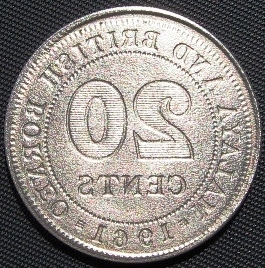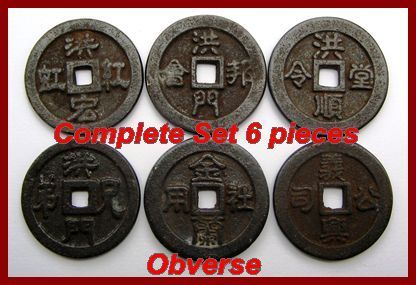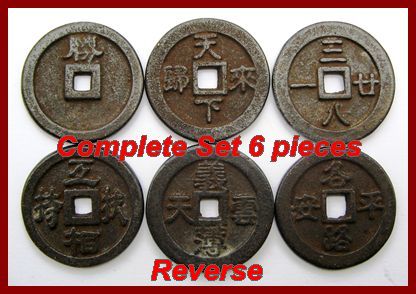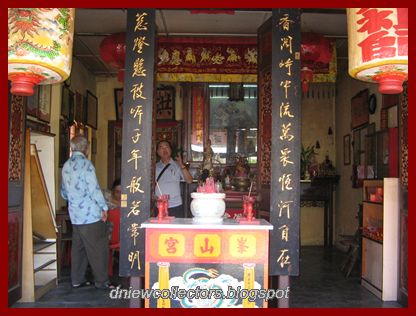Malaysia Chinese Secret Society "Hong Men" Identification Tokens. Set Of 6 Pieces.(1)Rarity:
RRRR http://dniewcollectors.blogspot.com/2013/05/hong-men-chenese-secret-society.html
On 20 April 2013 in the Numismatic Society (Asia) Coins & Banknotes Auction 1/2013 in Singapore, this
Malaysia Chinese Secret Society "Hong Men" Identification Tokens. Set Of 6 Pieces. was auctioned offat a realised price of S$800 (RM2000).This Hong Men tokens were made of alloyed metal, there were minted in 1946-1948 and were found in their center at Lorong Kampung Kuli ,Malacca.Here was the research done by Professor Lau Kia Ping and Mr. Wong Hon Sum.Secret societies in Singapore and Malaya: Developments and identification token money By Wong Hon Sum
, Singapore
After the Manchurian army invaded China to establish the Qing Dynasty and the anti-Qing regime of Zheng Cheng Gong (郑成功) in Taiwan collapsed in 1683, some Han Chinese who still upheld the ideal of overthrowing the Qing Dynasty to restore the Ming Dynasty were forced to flee China. These exiles were then scattered in Thailand, the Nanyang Archipelago, the Malay Peninsula, North Borneo etc. They maintained contacts with Tian Di Hui (天地会, Heaven and Earth Society) or its branches in China with the hope of planning to attack areas in the southern coast of China in their effort to work with Tian Di Hui for fighting the Qing government to revive the Ming Dynasty. These overseas conspiracies had generated concern of the Qing government, prompting Emperor Kangxi (康熙) to order clamp down actions on the oversea anti-Qing Chinese and to strictly prohibit their return to China. The early political exiles were thus sowing the seeds of secret societies in Southeast Asia as they gathered to form Tian Di Hui branches or the factions of its ally organizations.
Tian Di Hui was a non-governmental secret society that had been rather influential in early Qing Dynasty. Its name could be traced to its belief of “worshipping the heaven as father, the earth as mother, the sun as brother and the moon as sister”. Members of the society were known as brothers and given the surname “Hong” (洪), which was taken from “Hong Wu” (洪武), the year title of Ming Tai Zu (明太祖), who was the founding emperor of the Ming Dynasty. The society was also called “hong men” (洪门), meaning “hong family”, and the Chinese character “hong” (洪) was broken down to its basic strokes and designated as “three eight twenty one” (三八二十一) for use as the secret identification code among its members. The society’s rules demanded that members who joined earlier be addressed as “elder brothers” (兄) and those who came in later as “younger brother” (弟). With continually rising number of new members, which meant that more younger brothers were added, the society was also known as “adding younger brothers society” (添弟会)。
![]()
The Chinese who migrated to the Malay Peninsula comprised those who tried to escape from the rule of the Qing Dynasty as well as those who personally wanted to pursue economic development. Bukit China in Malacca is considered the oldest Chinese historical heritage in the country. Some of the old tombs found there are dated back to the 16th century and earlier. The ruling regimes then (the Portuguese and Dutch governments) adopted the Kapitan system (Kapitan,a Dutch word which is equivalent to Captain in English, means “tribal chief” in Chinese). Chinese leaders who were appointed as Kapitans were responsible for the proper management of the local people from their own ethnic group. Li Jia (李甲), or Kapitan Li (“Jia” being the short form for the title Kapitan), was one of the founders of Cheng Hoon Teng Temple or Temple of Green Cloud (青云亭), the oldest temple in Malacca. His full name was Li Jun Chang (李君常) and he was also known as Li Wei Jing (李为经). He hailed from Lu Jiang (鹭江), also known as Xiamen (厦门), in Fujian (福建)province. The Chinese cemetery land in Bukit China was in fact donated by Li Jia. Li Jia’s son, Li Zheng Hao (李正豪), succeeded him as the Kapitan. Subsequently, Li Zheng Hao’s brother-in-law (his sister’s husband) Zeng Qi Lu (曾其禄), alias Zeng Liu Guan (曾六官), became the Kapitan. Zeng Liu Guan was in fact a fugitive who fled China. He had contributed much to the construction and extension of the Cheng Hoon Teng Temple building. He built the Guang Yin Tang (观音堂) or Guan Yi Hall in the temple and a wooden plaque installed in the hall bears the Chinese characters “Qing Yun Gu Ji” (青云古迹) meaning “Green Cloud Ancient Heritage”. It was said that these four Chinese characters were written by Li Jia. In Cheng Hoon Teng Temple, there is still the memorial tablet shrine of Zeng Liu Guan, which indicates him as “bi nan yi shi” ( 避难义士), meaning “a righteous personality seeking refuge”. This is indication that Zeng Liu Guan had opted to seek refuge in another country instead of living under the rule of the Qing government. It can thus be seen that the off-springs of these political exiles had formed the core of the Chinese community in Malacca and they lived in a self-governed environment that allowed them to pursue their own careers, thus contributing to the prosperity of the local community. They were aware that they were not able to fight the Qing government as they remained overseas and that it was impossible for them to have any chance of starting an anti-Qing reform movement outside China. Their anti-Qing conviction was thus gradually forgotten following the passage of time and personnel changes. However, the activities and organizational networks of these secret societies subsequently evolved to become part of the social control mechanism.
In 1786, the British established in Penang the first colony in the Malay Peninsula, marking an important new beginning for the migration of the Chinese to Southeast Asia. The free trade policy implemented in Penang attracted many Chinese immigrants who aspired to achieve better progress. Subsequently, the opening of Singapore in 1819 and the control of Malacca by the British in 1824 further boosted the inflow of the Chinese immigrants. In 1826, the British established the Straits Settlements and this development had strengthened the belief held by the free traders from China that commerce in this region would continue to flourish.
![]()
By 1825, the government of the Straits Settlements had discovered the existence of four Chinese secret societies, i.e. Yi Xin (义兴), Hai Shan (海山), He Cheng (合成) and Hua Sheng (华生). In the initial period, the secret societies set up their headquarters in Penang with branches in various parts of the Malay Peninsula, of which the most important locations were Sungai Seremban in Negeri Sembilan, Larut in Perak, Lukut in Selangor as well as Kuala Lumpur, Kanching etc that developed later. These areas were producing tin in the 19th century and many Chinese tin miners were important leaders in Yi Xin and Hai Shan. Due to conflicts of power and interests, there had occurred many cases of violent clashes between these two secret societies.
Yi Xin Company in Singapore had its members from five major dialect groups, namely Cantonese, Hakka, Hokkien, Teochew and Hainan. Although these dialect groups belonged in name to Yi Xin, they were in fact managing their own affairs separately. Such a situation led to repeated armed clashes among members of these dialect groups in Singapore in later years. Finally the British colonial government enforced various regulations to control the activities of these secret societies. In 1890, Yi Xin Company in Singapore was officially banned by the British colonial government.
When the British colonial government took action to ban the activities of the secret societies in Singapore, it had requested the Sultan of Johor to take similar action on Yi Xin Company in Johor. However, the Sultan declined and wrote back to the Governor of the British colony, explaining that Yi Xin Company was an organization officially recognized with his consent and it had impacts on the Chinese living in Johor. Since it was an organization beneficial to the people, he would not agree with the oppressive policy implemented by the British colonial government. The Sultan also pointed out that the existence of secret societies could not be eradicated by laws and the best way was to gradually change their nature over time. The method of control as mentioned by the Sultan was to require Yi Xin Company to open to all Chinese even though it was an organization formed by the Teochew dialect group, and all the Chinese Kapitans and “gang zhu” (港主) (kangchu, meaning “river lords”) must become its members.
By that time, the Industrial Revolution of Europe which started in the 19th century had led to the emergence of the textile and leather industries that stimulated the demand for gambier. This attracted the interests of the Chinese to plant this crop. Gambier is a small climbing plant and its leaves and branches can be boiled in water to form a paste of red brown colour which can be used as a dye for leather and textiles. Due to the strict control of secret societies by the British colonial government in Singapore, the leader of Yi Xin Company, Chen De Hai (陈德海), led more than 4,000 members to migrate from Singapore to Johor in 1846 to plant gambier and pepper. The development of the Kanchu system then implemented in Johor was related to Yi Xin Company. Several well-known kanchus in Johor, such as Chen Kai Soon (陈开顺), Chen Xi Nian (陈旭年), Chen De Hai (陈德海) and Lin Ya Xiang (林亚相), had all been leaders of Yi Xin Company. As such, Yi Xin Company in Johor was the only secret society in Johor that was given a legal status. Although its members came mostly from the Teochew dialect group, its special status had gradually attracted Chinese from other dialect groups to join in as members. It was thus able to become a local non-governmental organization that transcended the barriers of dialect groups and contributed to the stable economic development in Johor.
(The author is founding president of Numismatic Society (Asia)
,now serving as advisor to the society.)
(English translation by Ling Boo Chong) To be continued.......................




































































































.jpg)
.jpg)




